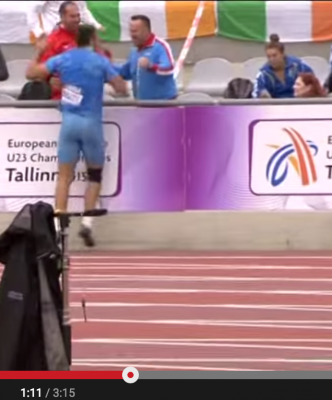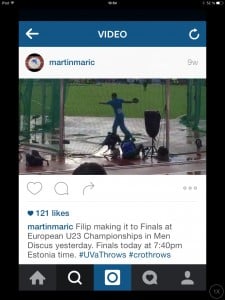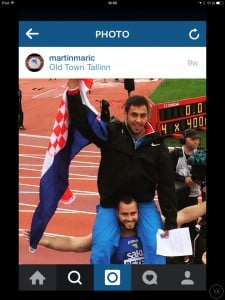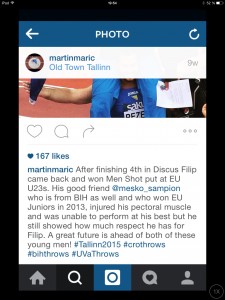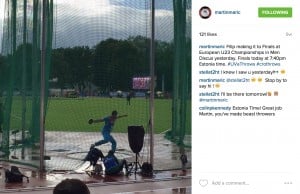University Of Virginia Employing Banned Doper Martin Maric As Throws Coach; Coaches Association Honors Him As Regional Coach Of The Year
by Robert Johnson
September 18, 2015
(Editor’s note: We published two other stories on Maric:
November 6, 2015 UVA Has Reassigned Banned Doper Martin Maric To Intramural And Recreational Sports – He Won’t Coach Throws At UVA This Year
On September 10, 2014, two-time Croatian Olympian and 2009 NCAA discus champion Martin Maric was suspended from the sport of track and field for two years by the Croatian Institute for Toxicology and Anti-Doping after he tested positive for ostarine, a selective androgen receptor modulator (SARM).
Guess what’s he’s been doing since then?
Coaching at the University of Virginia. And not just coaching. At the end of the track season in June, the coaches association (USTFCCCA) honored him as its outdoor men’s Southeast Regional Assistant Coach Of The Year.
When I was first given a tip about this story before NCAA outdoors, I figured there had to be something untrue about the story.
How could a banned thrower be a) allowed to coach by the the University of Virginia and the governing bodies, whether it be USADA, WADA or the NCAA and b) honored as coach of the year by his colleagues?
But a LetsRun.com investigation reveals that everything above is indeed true. Last year, Maric tested positive and was banned from the sport for two years. However, during that ban, he’s continued to coach at UVA in violation of that ban with zero repercussions. Not only have there been no repercussions, he was honored by his peers as the regional Assistant Coach of The Year.
Here’s the full story.
Maric Tests Positive
Last year, on July 13, 2014, Maric was given a drug test at the Croatian champs. It came back positive for the SARM osatrine. Maric was provisionally suspended on August 6, 2014, and formally sentenced for two years after a hearing on September 10, 2014, as explained here.
What is a SARM?
SARM stands for selective androgen receptor modulator. What does a SARM do? Well you can get a full explanation here from the steroid-focused website evolutionary.org courtesy of Dylan Gemilli but the CliffsNotes version is a SARM is designed to give one the benefits of steroids without many of the side effects. Steroids offer their muscle-building properties by binding to the androgen receptor, but there are often side effects like male pattern baldness, acne, body hair growth, shut down of one’s own testosterone production, etc. SARMs are designed to selectively bind to the androgen receptor in a way that you get the benefits of steroids without most of the side effects.
As evolutionary.org says:
SARMs offer the benefits of traditional Anabolic Androgenic Steroids such as testosterone (including increased muscle mass, fat loss, and bone density), all the while, offering a much lower tendency to produce the unwanted side effects that come with steroids.
Evolutionary.org says the following about ostarine in particular:
It also displays a very anabolic effect on muscle tissue, causing considerable and easy to maintain gains in muscle over 4-6 weeks, with little to no sides and no real PCT is needed afterwards, just a mild test booster like HCGenerate.
Another interesting aspect, as opposed to your typical steroid, is that SARMs remain very hard to detect for anti-doping agencies. Since SARMs bypass the well known 4 ring steroid structure, they are not steroids. However, SARMs exert many of the same performance enhancing effects that steroids do, without the side effects.
Anyway, Maric was banned from the sport and as part of that ban, he was not to “participate in any capacity in any Competition or activity” including “Competitions authorized or organized by any professional league or any international- or national-level Event organization or any elite or national-level sporting activity funded by a governmental agency” as explained by WADA code article 10.12.1 and IAAF competition rule 40.12 (a).
IAAF rule 40.12 (a) clearly states that coaching is prohibited – “The term ‘activity’ for the purpose of this Rule includes without limitation participating in any capacity, including as an Athlete, coach or other Athlete Support Personnel.”
Yet, the NCAA, the University of Virginia and Maric ingored the coaching part of Maric’s ban by allowing him to continue to coach. They may have done so thinking there could be no repercussions as while the NCAA championships are clearly a “national-level sporting activity”, the NCAA isn’t a signatory of the WADA code.
I started my investigation by reaching out to the Tom Lewis of the USTFCCCA at the NCAA meet to see if they were aware of Maric’s situation and that they’d just honored a man currently serving a doping ban as a Regional Assistant Coach Of The Year. The USTFCCCA issued the following statement, “Pursuant to USTFCCCA protocols, all institutionally-verified coaches of member programs are eligible for award nomination and selection.”
WADA’s and UVA’s Response
I then reached out to the World Anti-Doping Agency (WADA) to see if it was true that Maric, from my reading of the statutes, was in clear violation of his ban by acting as a coach at the University of Virginia and got this response:
“The NCAA is not a signatory to the World Anti-Doping Code, therefore WADA does not monitor its anti-doping programme. You may wish to contact the NCAA or USADA for more information.”
I then sent an email to Maric and Bryan Fetzer, the director of the University of Virginia track and field program, in which I asked them several questions about Maric’s situation. I was told that Craig Littlepage, the director of athletics at Virginia, would be the one responding to my questions. After a series of phone calls, Mr. Littlepage issued the following statement via email:
In response to this situation, Coach Martin Maric promptly informed the University of Virginia Department of Athletics about the results of this test. After a full inquiry, the Croatian Toxicology and Anti-Doping Agency determined the incident to be “unintentional” that is, not deliberate — resulting from use of a product tainted with a banned substance. Some evidence of the unintentional nature was that the particular substance at issue — while banned — was not one that provided a competitive advantage in these circumstances.
Coach Maric has been fully cooperative and honest in all of his communications regarding this incident. He has spoken to members of the University’s team, to prospective student-athletes and their parents, and to the media.
As a result, we are confident that this personnel matter has been handled in a manner consistent with University and Athletics Department policies.
In a follow-up phone call with Littlepage, I asked him for some supporting documentation and specifically asked if I could see a copy of the report from the Croatian Institute for Toxicology and Anti-Doping for Maric. It struck me as strange that if they had indeed found his doping violation to be “unintentional” and “not one that provided as competitive advantage” that his ban hadn’t been reduced per WADA article 10.5, which says that if a positive test is the result of “no significant fault or negligence” that the suspension can be cut in half (that’s per the 2009 WADA Code; the 2015 WADA Code says it can be totally eliminated). I was wondering if the Croatian anti-doping authorities really said that in their report or if Maric just claimed that to be the case in his explanation to UVA.
Littlepage refused to provide me with the report and said I would have to have permission from Maric to see it as it was part of his personnel file.
I then asked both Maric and Littlepage for access to the file via email. They didn’t provide it.
I also asked for the following:
- The rationale the Croatians used to determine his positive test to be “unintentional” and that the SARM ostarine was not something that “provided a competitive advantage.”
- An explanation for why Maric’s suspension wasn’t reduced from two years per WADA article 10.5 if it was the result of an unintentional and not performance-enhancing act.
- If UVA received confirmation from anyone at the IAAF or WADA that by coaching, Maric isn’t violating his WADA ban. I told them it was clear to me that Maric was specifically forbidden from being a coach by IAAF competition rule 40.12.
- Whether Maric was punished in any way by UVA for his positive test?
- A copy of the current UVA student-athlete handbook as I wanted to see if athletes at UVA would still be immediately suspended for a positive doping test.
In actuality, I didn’t need to ask UVA for a copy of the student-athlete handbook to see if Maric would currently be suspended from the UVA team if he was athlete. Somehow I forgot that after LetsRun.com raised a stink about sprinter Steve Mullings being eligible to run in the 2005 NCAA Outdoor Championships despite being banned by Jamaica, the NCAA changed its rules and said that they would honor doping suspensions for athletes:
31.2.3.1.2 Positive Drug Test Non-NCAA Athletics Organization.
A student-athlete under a drug-testing suspension from a national or international sports governing body that has adopted the World Anti-Doping Agency (WADA) code shall not participate in NCAA intercollegiate competition for the duration of the suspension.
The NCAA rule book doesn’t say anything about coaches. Yet another example of how coaches get one set of rules and athletes another with the NCAA (coaches change schools without sitting out a year, athletes often can’t).
UVA refused to answer all of my questions and refused to provide me with a current student-athlete handbook. Littlepage emailed back, “The background given in the email I sent you is what we’re providing. Coach Maric is out of the country.”
Using Google Translate, I then became aware that the Croatian announcement of Maric’s positive test didn’t mention anything about it being unintentional or non-performance-enhancing. I once again emailed the UVA coaches and Littlepage and provided them with the link to the Croatian statement and gave them one final opportunity to provide me with the supposed extenuating circumstances behind Maric’s positive test. They once again refused.
I was starting to think everyone was going to simply stonewall me.
USADA Seems Interested
However, I then reached out to the US Anti-Doping Agency (USADA) and they seemed interested in Maric’s case. It became apparent from talking to USADA that they believed any throwers at UVA who are subject to WADA testing (thus anyone throwing at USAs/Europeans/Worlds, etc.) aren’t allowed to be coached by Maric per WADA article 2.10: “Athletes and other Persons must not work with coaches, trainers, physicians or other Athlete Support Personnel who are Ineligible on account of an antidoping rule violation.”
Working with a banned person is itself a doping violation subject to a 1-2 year ban, but only if the athlete “has previously been advised in writing by an Anti-Doping Organization with jurisdiction over the Athlete or other Person, or by WADA, of the Athlete Support Person’s disqualifying status and the potential Consequence of prohibited association and that the Athlete or other Person can reasonably avoid the association. ”
As I waited for USADA to get back to me with an official statement, I also tried a long shot and sent off a fax to the Croatian Institute for Toxicology and Anti-Doping (no email was listed). I told them I had recently contacted the University of Virginia, where Maric worked, and asked them if was indeed true that Martin Maric’s ban had been determined to be “unintentional” and “not one that provided as competitive advantage,” and if so, why wasn’t his ban reduced? The Croatians didn’t answer my questions directly but did seem interested that he was coaching and said they would take “appropriate” action as shown by the emailed response that I received on July 15:
Dear Mr. Johnson,
Thank you very much for you letter sent via fax on 10 July 2015.
Mr. Martin Maric has been banned from attendance at and participation in any and all sports competitions and activities in duration of two years by the Decision of the Disciplinary Hearing and Ruling Panel of the Croatian Institute for Toxicology and Anti-Doping (CITA) based on Article 10.2 of the CITA Anti-Doping Rules. He breached Article 2.1 of the CITA Anti-Doping Rules related to Category S.1.2-Other anabolic agents of the Prohibited list.
The Decision was adopted on 10 September 2014. The penalty includes the period of provisional suspension imposed by the CITA Decision of 6 August 2014, so that penalty shall expire on 5 August 2016.
On the basis of information contained in your letter, CITA will take appropriate actions in accordance with its authority.
Kind regards,
Snježana Karlo
Head of Anti-Doping Section
Croatian Institute for Toxicology and Anti-Doping
As the summer moved on and I still awaited for a final statement from USADA, I received a tip. Here is a video of a man who appears to be Maric at the European Junior Championships this summer, where UVA thrower Filip Mihaljevic won gold for Crotia in the shot put.
https://www.youtube.com/watch?v=tdlYuccvKeI
After Mihaljevic won gold on July 12, he runs over to the stands and the first person he appears to hug is someone whom we believe to be Maric (in red).
Maric was 100% at the meet as shown by these instagram posts (click for larger image).
Are we supposed to believe Maric was simply a fan in the stands?
(Editor’s note: Mihaljevic won gold three days before Johnson received the statement from the Croatian anti-doping agency).
This week, USADA finally got back to me with a statement.
We are aware of the situation and we have been in contact with the University of Virginia about Mr. Maric and the Prohibited Association Rule. We are hopeful that the University will shortly bring this situation to a satisfactory conclusion, in accordance with the rules.
Additionally, you may find it relevant that yesterday Martin Maric was identified on the Prohibited Association List published by the World Anti-Doping Agency. You may find this list at: https://wada-main-prod.s3.amazonaws.com/resources/files/wada_prohibited_association_list_with_disclaimer_en_14sept2015.pdf
So there you have it.
Everything now seems pretty clear. The University of Virginia’s throws coach Martin Maric, who is currently in the midst of a two-year doping ban, now publicly appears on the Prohibited Association List. UVA is aware of it, which means anyone at UVA who is coached by Maric until August 5, 2016, should also be banned if they compete in an event subject to WADA testing. Any ban from WADA would carryover to the NCAA.
The only potential out is somehow if lawyers for the athletes at UVA get involved and perhaps try to argue that the athletes can’t “reasonably avoid the association” with Maric as he is the coach at UVA. One would think WADA’s response would be that they could get someone else at UVA to coach them or coach themselves if UVA continues to employ him during his ban.
The one remaining question is will Maric’s ban extended since he clearly has coached during it.
More: Discuss this topic on our message board. MB: UVA Coach Serving Doping Suspension
Other Coverage On Maric:
November 6, 2015 UVA Has Reassigned Banned Doper Martin Maric To Intramural And Recreational Sports – He Won’t Coach Throws At UVA This Year



